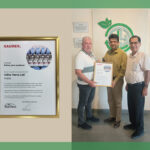
Usha Yarns Achieves another Milestone as First Com4recycling-Rotor Licensee of Rieter
March 13, 2024
Usha Yarns Recognized by Saurer for their Contribution to the Development of Rotor Spinning Technology for Recycled Yarns
November 20, 2024Guardian to Visionary: Navigating the Intersection of Mechanical and Chemical Recycling for the Future of Sustainable Textiles
Guardian to Visionary: Navigating the Intersection of Mechanical and Chemical Textile Recycling for Sustainable Futures

Emphasizing the crucial role of mechanical textile recycling as we navigate towards the horizon of chemical recycling's full potential paints a vivid picture of a battleground in environmental conservation. Here, mechanical recycling stands as a steadfast guardian, holding the line against the relentless surge of textile waste. This isn't just a stopgap measure—it's a vital, strategic defense in our fight to preserve resources and protect our planet.
Mechanical recycling, with its current technology, acts as the unsung hero. It’s akin to a field medic, providing immediate, although not perfect, solutions to the wounds inflicted by fast fashion and disposable textile practices. By extending the life of textile fibers, even with the compromise on quality, this method diverts massive amounts of waste from landfills and reduces our dependency on virgin resources. It's a testament to our ability to do more with less, to extract value from the seemingly valueless.
However, the dream of a closed-loop, zero-waste textile industry lies beyond the reach of mechanical recycling alone. Enter chemical recycling—a beacon of hope promising to transmute worn-out, mixed-material textiles back into pristine, high-quality fibers. This isn’t just recycling; it's alchemy, transforming the old into the new with the potential to disrupt the very foundations of textile waste.
Yet, as we stand today, chemical recycling is a horizon glimmering with promise but blurred by challenges. The path to its full integration is fraught with technical, economic, and environmental obstacles that need to be meticulously navigated. It’s here, in this gap between the present struggle and the future’s potential, that mechanical recycling not only buys us time but also lays the groundwork for a more sustainable future.
By optimizing and expanding mechanical recycling efforts now, we're not just managing waste; we're building a launchpad for the next leap in textile sustainability. Every garment recycled mechanically is a lesson learned, a resource saved, and a step closer to a world where textile recycling is no longer just about managing waste, but about powering a circular economy.
This moment calls for bold investments, innovative thinking, and collective action. It's time to rally support for both mechanical and chemical recycling, ensuring that when the latter's moment comes, it will find a well-prepared field, fertile for revolutionizing textile sustainability. The journey from guardian to visionary isn't easy, but it's one we must undertake to weave a future where every fiber counts, and no garment's story ends in a landfill.






